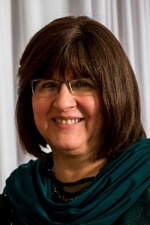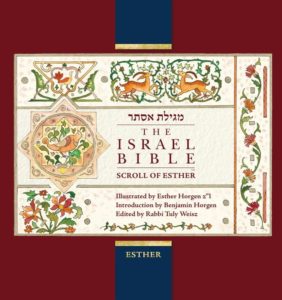By Toby Klein Greenwald

It is always amazing to me how there are families who react to unbearable tragedy by creating something deeply meaningful and beautiful for the Jewish people and, indeed, for the world.
This is what the family of Esther Horgen has done. Esther, 52, was brutally murdered by a terrorist on December 20, 2020, who had waited for her in ambush, while out jogging in the Reihan forest near her home in Tal Menashe, in Samaria. It was a forest where she, and others, had run and walked many times before. Her body was discovered on December 21, at 2A.M.
She died on a beautiful winter day, the kind that happens in climates like Israel, where rather than snow on the ground, there is crisp air, the aroma of leaves and wildflowers, and a bright sun. Esther herself, many people have said, was a ray of light. She was a therapist and an artist, born in France and living with her husband, Benjamin, also French born, and six children, in Tal Menashe since 2001. Their youngest was 13-years-old and celebrated his bar mitzva a few months earlier. They also have several grandchildren. Benjamin relates that Esther wanted to make aliya since she visited Israel as a child, and finally arrived when she was 18.
Her family decided to not let her light be extinguished, and created The Israel Bible Scroll of Esther in her memory. It is in partnership with The Israel Bible series, a study bible that its editor, Rabbi Tuly Weisz, says, “…highlights the special relationship between the Land and People of Israel.” Their team of scholars are all Israeli Jews, but “our readers include many non-Jews who love Israel and who are eager to study Torah from a Jewish perspective.” This is a phenomenon that is more and more common today – non-Jews, not necessarily in the area of academia, with no plans to convert to Judaism, who are increasingly intrigued by the Torah, and are seeking books and courses on Jewish biblical commentary, Jewish philosophy, culture and history. He writes that they were aided by the staff of Israel365.
I perused this new Megilla, and it is unlike any other I have seen. I write that as someone who has researched, studied and taught Megillat Esther and has co-authored and directed an entire biblical musical on Esther.
The Israel Bible Scroll of Esther is unique. It features Esther’s exquisite illustrations, alongside the text of the Megilla in Hebrew and English, and a new commentary from Rabbi Weisz. Some key verses also appear in transliteration, as do the blessings before and after the Megilla, and some additional texts, such as a Prayer for the State of Israel, a Prayer for The Welfare of Israel’s Soldiers and Hatikvah. It also has photographs of Esther on her hikes in that same forest. Esther’s husband says that she created many works of art.

Esther’s Megilla also includes rich and varied resources: An essay on the historical background to Purim, a list of the prophets and their locations in the biblical texts, the Hebrew months and their holidays, with explanations, a map of the empire of Ahasuerus and, for context, a map of modern-day Israel and its neighbors.
The scroll includes blessings from the person who was at that time Israel’s President, Reuven Rivlin, who wrote, “I join with you in celebrating the life of Esther…How bittersweet to celebrate Purim, when we read the story of the triumph of Queen Esther over the wicked plans of Ahasuerus and his advisor the evil Haman to annihilate the Jewish people when we are mourning the loss of dear Esther.” It also has a letter of support and admiration from then Prime Minister Benjamin Netanyahu.
Esther’s husband of more than 30 years, Benjamin Horgen, writes in his heartfelt introduction, “My Esther was blessed with a rare quality – she saw the good in everyone, every place and every moment. She was a deeply spiritual person, who, like the Jewish Sages whose teachings had a profound influence upon her, viewed the world in three realms: Olam, Shana and Nefesh…” He explains the meaning of those three elements, and also describes how Esther loved to explore the land of Israel, and the entire world, “From Australia to Ireland, Sweden to India, Hungary to Brazil and many, many more, she loved every place and marveled at the beauties of this world with an infinite appetite.” She loved all the holidays, he writes, but especially Yom Kippur and Purim.
Upon concluding the week of mourning for Esther, the Horgen family went to the site of her brutal murder in the nearby forest, and planted a tree in her memory so that it would remain a place of peace, not a forest of fear. Proceeds from the sale of this scroll of Esther will go to developing the Esther Horgen Memorial Forest and Park in Tal Menashe.
Benjamin told me, in a phone interview, “Both I and my daughter, Avigail, took an active part in the creation of the Megilla. We are very moved by this project and are grateful to Rav Tuly Weiz and all those involved. I believe that it reflects quite well Esther’s personality in the aspects of her art works, and that she would be pleased with the results. Art was an important part of her life and it was inspired by nature, which she loved.” The book currently has the Megilla text and additional prayers in Hebrew and English, but the additional material is mostly in English. Benjamin says, “I hope that we will be able to publish it, including all the extras, in Hebrew and French. We are also working on a book that would include Esther’s hundreds of articles.”
A daughter remembers that terrible day
I spoke with, Avigail, 22, fourth of the Horgen children, who helped in the creating of the Megilla. She told the publisher about her mother, sent them photos and helped with the technical side. Avigail had studied computers in high school and did her National Service in Hilma – an organization that helps non-profits, hospitals and social services with internet and technological services. Now she is seeking work in hi-tech.
I asked her what she remembers from that day.
“I was home in Tal Menashe and around four o’clock I was looking for my mother and she wasn’t there so I assumed she was outside somewhere, as it was sunny. The truth is I was a bit worried; she was not answering her phone or replying to messages. But I told myself that it is nothing so I distracted myself. Then my father came home at 6PM after work. He went to look for her and asked me to stay home in case she returns. My neighbor arrived and she said that maybe her husband could locate my mother through her cellphone, through the internet, so he tried, and I tried with all the applications I know, but didn’t succeed in finding her. After the fact we realized that her phone was off and the murderer had removed her sim card.
“Then my siblings came home, and everyone went out looking for her; the security forces came to speak to us and also started to search for her. We slowly understood that something happened to her and that it was intentional. They asked me for her clothes, so the dogs of the rescue unit would be able to look for her. Eventually they found her and came to tell us what happened.”
Avigail described Esther as a mother. “In the Megilla you see that Queen Esther was brave; she goes to Achashverosh though she knew it was the death sentence [for going unsummoned], in order to save the Jews. My mother was also courageous. There were signs that she fought the terrorist hard. In her life she was also very brave. She loved to research what she didn’t know, and learn new things, whether about herself, about others, about cultures, about Judaism, about the soul. She wasn’t afraid of the unknown, she asked questions. I think that we need to learn from her, though it was a horrifying event. We have to go forward and not be afraid, but to continue our lives, with courage.”
Grassroots efforts to remember Esther
There were additional, grassroots initiatives that sprung up in reaction to Esther’s cruel murder, especially among women, who refuse to be bullied. On December 23, 2020, the day after Esther’s funeral, a large group of women in Efrat and Modiin walked and ran in memory of Esther. One of them, Elana Abelow Kronenberg, a mother of seven from Efrat, continued the tradition, even in the rain, and for many days she would post a photo called “Keeping the memory alive of Esther Horgen hyd #walkforesther“ on her Facebook page, on the background of a beautiful scene in nature. (The “hyd” stands for “Hashem yikom dama” – “may her blood be avenged.” Among its sources is one in the book of Devarim [Deuteronomy] 32:43: “O nations, acclaim His people! For He’ll avenge the blood of His servants.” [Translation from Sefaria]). At the time, Elana told me, “I walk almost every day in memory of Esther hyd to make sure she is always remembered, never forgotten, giving strength to her family and others, and all she stood for. With each step I take, it shows permanence for our right to live here, and I choose to not let fear hold me back, as we have a right to exercise for our physical, spiritual and emotional freedoms.”
The Megilla includes a poem, originally written as prose, called “Fear,” that Esther wrote in 2015, following a series of terrorist murders, including one in which a boy was stabbed just weeks before his bar mitzva. He was very badly wounded, though, thankfully, he survived.
An excerpt from that prose-poem:
And whenever a situation reminds me of my helplessness,
like seeing a child stabbed a month before his Bar Mitzvah,
our prayers join with his mother’s prayers,
crossing hearts beyond the oceans,
imploring the Divine Mercy that lies dormant within us.
It is from the depths of our helplessness that we encounter Omnipotence.
You have to live it to understand it.
Benjamin writes, “As the tragic abduction of Queen Esther led to the salvation of the entire Nation of Israel… we believe that my Esther’s fate is also the harbinger for future blessings and ultimate goodness for the Jewish people and all of humanity. May her soul be bound in the eternal bonds of life.”
The Jewish people have had many Esther’s, of every gender – courageous individuals who love and serve their people.
The Israel Bible Scroll of Esther can also be ordered as a PDF file.
*
The writer lives in Israel and is an award-winning journalist, artistic director of Raise Your Spirits Theatre and editor-in-chief of WholeFamily.com.